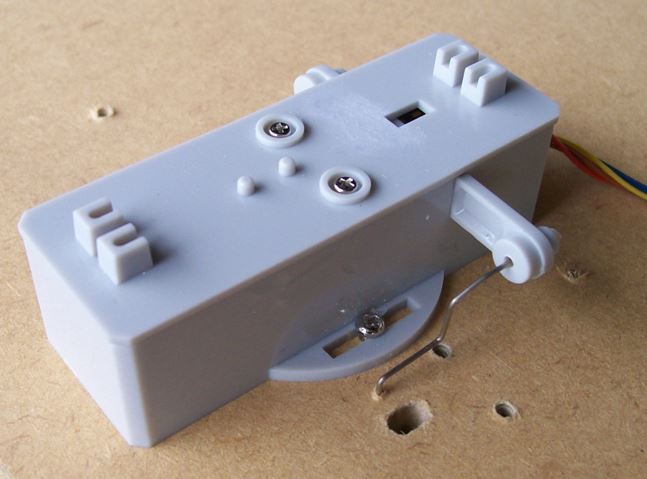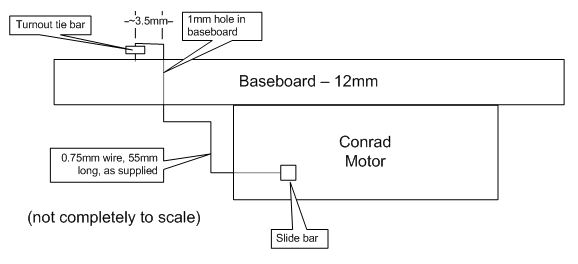Everything on model trains, model railroads, model railways, locomotives, model train layouts, scenery, wiring, DCC and more. Enjoy the world's best hobby... model railroading!
Confused With Track Wiring?
Bill operates N gauge and is confused with wiring requirements. He asks readers:
“I am just building a two mainline track with two side tracks going to separate buildings and terminating at each. There are two points wired, but but they seem to operate the track… in other words when a train passes one point, I have to switch the other point to keep the train moving. This is possibly simple to some? Who knows? Can you help please?”
How to Power Bachmann EZ Track
Linda has a question for HO enthusiasts:
“Hi – I want to have 3 HO trains running on 3 circle tracks. I want the roadbed type of track and have only been able to find 3 different size curves in the Bachmann EZ track. 15″ 18″ and 22″. The 18″ has a rerailer section that I can get to power that track. But I cannot find how to power the 15 and 22… I saw on a site that you can get the atlas terminal joiners, but do not see how you can install them with the EZ Track roadbed. Help please.”
Adding an Elevated Line to Layout
Daniel models O scale and is confused with a project he is working on:
“I want to add an elevated line on my O scale layout. I purchased two sets of older trestles , 2110 & 110 sets. Both say can use for O Gauge. With plastic H shaped brackets there is no way three rail tubular track can be installed. What do I have? Have seen metal U shaped brackets on line. I would appreciate input and guidance from others.”
Animal figurines for Model Railroad
 To look real a model railroad usually has an assortment of scale model people and animal figurines strategically located in appropriate positions on the layout. Dave has some specific requirements:
To look real a model railroad usually has an assortment of scale model people and animal figurines strategically located in appropriate positions on the layout. Dave has some specific requirements:
“Does anyone know where I can purchase HO scale figures of pronghorn antelope, mountain goats, bighorn sheep, and/or longhorn cattle?”
Replacing Cracked Driving Gears on Trucks of 3 Truck Shay Locomotive
Kevin (a regular contributor to this blog) finally gets to ask his own question:
“Hi, I live in New Zealand and model in HO scale, however I have a Bachmann 3 truck shay loco and the driving gears on the trucks have cracked, and as such do not drive the loco. I tried contacting the new Zealand agents for replacement steel gears, but they can only supply the plastic ones, and said they could not guarantee that the same thing would happen again. Does anyone know where I can get the steel ones from and approx cost thanks?”
If anyone can assist Kevin, please add a comment under this post.
How to Stop Trains Stalling on DCC Layout
Ian models OO gauge (similar to HO scale) and asks readers:
“I have converted my circuit layout to DCC and sometimes trains stall. Usually a certain train will pause in a certain place on the layout but not all the time and not all my trains do it. One train pauses not far away from the main feed. Some pause on points, but I have clips fitted to create continuation of current. If anyone can advise on how to eliminate this, I would be grateful.”
Fun-To-Make Real Looking Silos
This short video shows plans for three scale model silos you can make yourself. They are already detailed to an exceptionally high standard, so you won’t need to do any airbrushing or painting.
- Silo facility No.1 (plan # B530) the Silo Storage Company Silos
- Silo facility No. 2 (plan # B531) the Advance Rail Forwarders Silos
- Silo facility No. 3 (plan # B532) the Bulk Road & Rail Silos Silos
The plans for making these silos in HO, OO, S, Z, or N scale are available from http://www.modelbuildings.org/industrial-silos-models-to-make.html
Yes or No to N Gauge for Starters?
Ian is interested in returning to model r ailroading and asks:
ailroading and asks:
“I have been a previously train buff but now after retiring I have caught the bug again after seeing all the action on this blog. The area I have is 5×5 meters (16 foot square) my ex computer room and I am thinking N gauge (N scale) for maximum track and rolling stock. Any suggestions please? In the past I have been involved in electronics. Regards Ian”
Locomotive Run Sluggish
Henry asks readers:
“I have an 50 year old DC layout with several different types of locomotives which run smoothly. However, I have a Marklin (3034) Class E41 Electric Unit that runs very sluggish. I have check the pick up shoe which seems to be ok. Why do the other locos run ok but this Marklin one doesn’t?”
Hornby Ringfield 3/5 Pole Armatures
John models OO Gauge and asks readers:
“Help please. I have an old Class 110. 3 car multiple unit Hornby R369 with a 3pole motor which could perform better. So I saw a video on how to change to 5pole, but on my motor armature the new 5pole (Part No X9024) shaft is only 1.99 mm diameter and the old 3pole shaft is 2.37 mm diameter. I am informed that bushes are or were available to fit. Can any one help to find or know who makes them.”
Suitability of Conrad Point Motors
David from New Zealand kindly sent in this article to share –
Description of Conrad point motors and their suitability for my N gauge layout
 I have recently returned to railway modelling after more than 50 years and I spent quite a lot of time researching the current marketplace before buying any equipment. Having decided on N gauge (N scale in USA) because of space limitations, I set up a very simple test bed with some sections of Peco track and some turnouts, both insul-frog and electro-frog.
I have recently returned to railway modelling after more than 50 years and I spent quite a lot of time researching the current marketplace before buying any equipment. Having decided on N gauge (N scale in USA) because of space limitations, I set up a very simple test bed with some sections of Peco track and some turnouts, both insul-frog and electro-frog.
One of my aims was to have ALL the turnouts motorised, and the other was to use electro-frogs except possibly where no electro-frog version of the turnout was available, e.g. Peco ST44/ST45 curved turnouts. (I discarded these in the final layout as the radii were too small). So the hunt was on for point motors which could also switch electro-frogs, and which were affordable in quantity.
There’s no getting away from the fact that the Peco point motor is designed for OO/HO. It will fit under an N gauge turnout but the movement of N gauge turnout blades is only 3mm. Therefore it is difficult to get accurate and reliable operation with N gauge, particularly when you add a microswitch unit to the motor. A Seep point motor works on the same principle and with those, the built-in frog switch only just works because of the limited turnout-blade movement.
Testing the Conrad
During my investigations I came across a couple of short videos about the Conrad point motor, so I bought a couple of motors and tested them. The basic design of the Conrad motor is to use a stiff wire directly up through the baseboard into the tie bar. This works OK with OO/HO turnouts (and probably O gauge as well, but I have no experience there) but again, it doesn’t work too well with the short travel of N gauge turnouts. However, one of the videos shows the use of a crank and I can confirm that this works brilliantly. The crank reduces the motion of the Conrad slider bar from 7mm to 3mm, and it’s easy to adjust. The Conrad motor includes a frog switch so you don’t have to buy any extra parts to operate electro-frog turnouts. I have successfully installed 31 Conrad motors on my current layout and I’m very happy with them.
How do the Conrads work?
They are based on a 12V DC motor turning a crown wheel, with a slide bar engaging the shaft of the crown wheel. They are NOT slow-acting like a Tortoise or a Cobalt motor, but they are not nearly as “violent” in action as a solenoid. Limit switches cut off the motor power at each end of the travel of the slide bar. The electrical design allows operation on AC or DC. In AC mode, the wiring is identical to that of a solenoid motor, but you can get away with a simple SPDT switch in place of a passing contact switch.
In DC mode, you use two power supplies (+12V & -12V), and here you get the greatest advantage – you only need ONE control wire plus the common return. If you don’t have a dual DC power supply, you can always use a single 12v supply and a DPDT switch to reverse the voltage supplied to the motor, but there again, you would probably use the AC method instead.
Size: The Conrad motor is 70mm long, 25mm wide (38mm over the mounting flanges), and 26mm deep. The slide bar is 47mm long overall and moves about 7mm. The shallow depth means that these motors are well suited to being used on “upper levels” where you need clearance for trains running underneath them.
The crank: The above sketch shows what I mean by the crank. I use the thicker of the two pieces of wire supplied with the motors. This is 55mm long. The hole in the baseboard serves as the pivot for the crank. The photos below illustrate this in practice – on my test-bed. You don’t need to remove the over-centre spring from the turnout. I still make an elliptical hole under each tie bar just in case I want to use a solenoid motor at a later date.
Pricing and availability
The Conrad motor (part number 1396900) is available from Conrad UK (conrad-electronic.co.uk) at £9.99, including VAT but not including shipping. Conrad UK will not ship internationally so the VAT does not come off. From Conrad.com (Germany), they are available with a quantity discount, coming down to €6.93 when the VAT has been taken off for export. The snag is that there is a €55 shipping charge, which looks horrendous. However, if you buy a quantity, the pricing comes out roughly as follows (but don’t hold me to it as rates can vary): 10 cost roughly NZ$33 each, 20 cost roughly NZ$17 each. The most you can order while staying below the NZ$400 limit is 27 or 28.
Thanks David. If you have an article you would like to share with others, please submit details to the Blog Moderator using this link http://www.model-train-layouts.net/Submit-An-Article.html
Lionel Accessory Problem
 Alan models O scale and wants advice from other Lionel enthusiasts:
Alan models O scale and wants advice from other Lionel enthusiasts:
“I purchased a used Lionel 6-12915 Log Loader; Lionel #164 Log Loader. It is in good shape and all electrical parts function perfectly. The problem I have relates to the chain drive system. The chain on the right side is loose with a significant amount of slack in it such that two of the three spades flop down from the weight of the log and the log falls off. I need to know how to adjust the tension on the loose chain so that all of the three pairs of spades will lift the logs up into the loader section. Any assistance will be appreciated.”



















